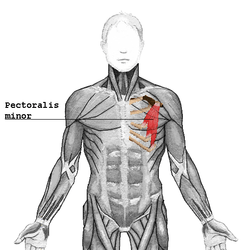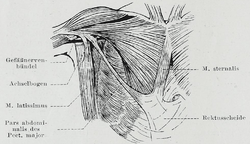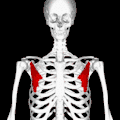Pectoralis minor
| Pectoralis minor | |
|---|---|
 Pectoralis minor (shown in red). | |
 Pectoralis minor muscle (shown in red). The bone shown in blue is the shoulder blade. | |
| Details | |
| Origin | Third to fifth ribs, near the costochondral junction |
| Insertion | Medial border and superior surface of the coracoid process of the scapula |
| Artery | Pectoral branch of the thoracoacromial trunk |
| Nerve | Lateral pectoral nerve |
| Actions | Stabilizes the scapula by drawing it inferiorly and anteriorly against the thoracic wall, raises ribs in inspiration |
| Identifiers | |
| Latin | Musculus pectoralis minor |
| TA | A04.4.01.006 |
| FMA | 13109 |
| Anatomical terms of muscle | |
The pectoralis minor (/ˌpɛktəˈreɪlɪs
Structure
It arises from the upper margins and outer surfaces of the third, fourth, and fifth ribs, near their cartilages and from the aponeuroses covering the intercostalis.
The fibers pass superior and lateral and converge to form a flat tendon, which is inserted into the medial border and upper surface of the coracoid process of the scapula.
Relations
The pectoralis minor muscle is covered anteriorly (superficially) by the clavipectoral fascia. The Medial pectoral nerve pierces the pectoralis minor and the clavipectoral fascia. In attaching to the coracoid process, the pectoralis minor forms a 'bridge' - structures passing into the upper limb from the thorax will pass directly underneath.[1]
Axillary nodes are classified according to their positions relative to the pectoralis minor muscle. Level 1 are lateral, Level 2 are deep, Level 3 are medial. The pectoralis minor divides the axillary artery into three parts (in contrary sequence compared to the nodes) - first part medial, second part deep/posterior, third part lateral in relation to the pectoralis minor.
Variations

The origin is from the second, third and fourth or fifth ribs. The tendon of insertion may extend over the coracoid process to the greater tubercle. It may be split into several parts. Absence of this muscle is rare but happens with certain uncommon diseases, such as the Poland syndrome.
Function
The pectoralis minor depresses the point of the shoulder, drawing the scapula superior, towards the thorax, and throwing its inferior angle posteriorly.
Additional images
 Position of pectoralis minor muscle (shown in red).
Position of pectoralis minor muscle (shown in red).- Right pectoralis minor muscle. Deep dissection.
References
This article incorporates text in the public domain from page 438 of the 20th edition of Gray's Anatomy (1918)
External links
| Wikimedia Commons has media related to Pectoralis minor muscles. |
- Illustration: upper-body/pectoralis-minor from The Department of Radiology at the University of Washington
- Anatomy figure: 04:04-05 at Human Anatomy Online, SUNY Downstate Medical Center
- Anatomy figure: 05:02-08 at Human Anatomy Online, SUNY Downstate Medical Center
- Anatomy photo:05:ov-0200 at the SUNY Downstate Medical Center
- Anatomy photo:05:01-0102 at the SUNY Downstate Medical Center
- Slide
- Muscles/PectoralisMinor at exrx.net